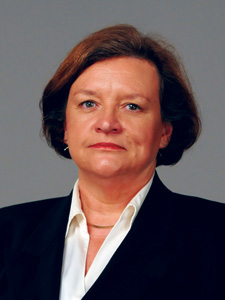Citizens Insurance on Target To Drop Below 650,000 Policies
December 11, 2014
The effort to move customers into the private market will slow at Citizens Property Insurance Corp. now that the state-backed insurer has cut its number of policies in half over the past two years.
 Still, about 100,000 more policies could be pushed into the private market during the next year, Citizens President and CEO Barry Gilway told members of the insurer’s Board of Governors on Wednesday.
Still, about 100,000 more policies could be pushed into the private market during the next year, Citizens President and CEO Barry Gilway told members of the insurer’s Board of Governors on Wednesday.
“While depopulation will be slowing, as we begin to look more like the market of last resort we were created to be, we’re still forecasting to be well below 650,000 next year,” Gilway said.
Citizens, which peaked at 1.5 million policies in August 2012, was down to 727,122 policies as of November 30. The insurer this year set up an electronic clearinghouse aimed at moving property owners to the private market.
Also, in January, more than 182,000 policies now in Citizens will be available to be picked up by nine private carriers in a process known as “takeouts.” For February, five companies have been approved to receive up to 132,941 residential policies. In both cases, the overall number of policies eventually shifted is not expected to reach the approved maximum, as private companies cherry-pick the least-risky policies and often go after many of the same customers.
On Tuesday, Citizens executives announced they are rewriting a letter sent to customers selected for “takeout” regarding policyholders’ rights in the process. Also, the letter will be sent earlier in the process.
Julie Jones Named New Florida Department Of Corrections Boss
December 11, 2014
Gov. Rick Scott on Wednesday tapped Julie Jones, a public-safety veteran who retired earlier this year, to head the beleaguered Department of Corrections, an agency under state and federal scrutiny for inmate abuse, corruption and retaliation against whistleblowers.
Jones, the first woman to lead the corrections agency overseeing more than 100,000 inmates, retired this spring after a five-year stint as chief of the Department of Highway Safety and Motor Vehicles. Prior to that, Jones served more than two decades at the Florida Fish and Wildlife Conservation Commission, where she worked her way up to director of law enforcement before taking the highway-safety position in 2009.
 Jones had been the subject of longstanding rumors as Scott’s pick for the troubled corrections agency but said she was not contacted by Scott’s office until last week. Jones, 57, is Scott’s fourth corrections chief in four years. The most recent secretary, Mike Crews, retired late last month.
Jones had been the subject of longstanding rumors as Scott’s pick for the troubled corrections agency but said she was not contacted by Scott’s office until last week. Jones, 57, is Scott’s fourth corrections chief in four years. The most recent secretary, Mike Crews, retired late last month.
Jones takes over as the agency is grappling with investigations into inmate deaths at the hands of prison guards, lawsuits from whistleblowers who claim they faced retaliation for exposing cover-ups of inmate abuse and questions about inmate health care after the state’s privatization of health services began more than a year ago.
Known for her direct manner, Jones is highly regarded among lawmakers and lobbyists for her ability to reach consensus among entities that often have competing agendas.
Although she lacks experience in the prison arena, Jones said the department has plenty of experts on whom she can rely when she takes over the helm Jan. 5.
“My fresh perspective will enable me to look for different ways to do things. I don’t have to be an expert in order to implement change management. I’m good at the people part, and I’m good at the budget part. Hence on getting the current employees that are working as hard as they can the resources to do their job, I can do that. And I think that’s going to be the key to this,” Jones said.
Crews spent months trying to resuscitate the department’s image by purging rogue officers and imposing a “zero tolerance” policy for corruption and abuse before he stepped down in November. Crews’ reforms began this summer after reports of inmate abuse by prison guards that sometimes led to horrific deaths. He fired dozens of prison workers, initiated new standards for conduct and asked the Florida Department of Law Enforcement to investigate more than 100 unresolved inmate deaths.
Black leaders are asking the U.S. Department of Justice to expand an investigation into wrongdoing at several Florida prisons, already under scrutiny by the Federal Bureau of Investigation.
Meanwhile, a group of corrections investigators filed a lawsuit against Scott and other officials earlier this year, alleging they were retaliated against for exposing the death of an inmate that opened a floodgate of questions about prisoner abuse.
Crews, who repeatedly said he intended to “change the culture” within the corrections agency, was “on the right track” with some of the reforms he implemented, Jones said.
“The cultural change, though, you can tell people that you want them to act differently but if you don’t set standards and hold them accountable, it’s hard. That’s why the HR (human resources) piece and analyzing what their job is, being very specific about what is expected of them so there’s no gray area, that’s important and that will lead directly into the ethics piece that Mike has been working on,” Jones said.
Jones said her first order of business will be analyzing prison workers’ job tasks and staffing levels.
“I need to know what they’re doing, why they’re doing it and are they doing it appropriately. What’s their job? What can we automate? What do we need a corrections officer to be doing? Do we need additional technology? How do we make their job better? So we need to go in and do a complete assessment of what the job is,” Jones said Wednesday morning in an interview with The News Service of Florida.
The corrections agency has a $2 billion budget and has run a deficit in excess of $100 million over the past few years. One of Crews’ main complaints before he left the agency was that corrections workers, who have gone without raises for at least six years, are underpaid and overworked.
Jones said she could advocate for pay hikes with the Legislature and the governor’s office but only after her analysis is complete.
“The problem is we want to throw money at a problem. I need to understand what the problem is before we ask for money. Corrections officers have a really bad rap right now. So cleaning up the image, getting them the respect that they’re due is all part of then turning around and asking for compensation and everything that they have to work with,” she said. “I’m not going to tell you I’m going to go in and ask for a raise. … If we need to hire different people or better people and we can’t hire them at $32,000, then we’re going to have to do something about it. But the expectations are (to) get some good accountability measures associated with that job description. Then you can go to the Legislature very easily and say these people are underpaid. … Nobody’s done that. You can’t just keep asking for money without expressing what the problem is.”
Whistleblowers who have filed lawsuits against the state for retaliation after exposing wrongdoing have complained that many higher-level corrections workers involved in prisoner abuse or corruption get promoted while low-level staff lose their jobs.
“Nobody in this system is going to get a free pass,” Jones said. “I will also maintain that zero tolerance for corruption, for just basic human rights and how we treat people. A lot of the intimidation in the system is because they can get away with it. That’s not right.”
The “service piece” needs to “permeate throughout the corrections community,” Jones said.
“We have a responsibility to the people who are incarcerated to keep them safe and get them out of the system as quickly and judiciously as we can,” she said. “I can talk until I’m blue in the face that I want you to be kind and considerate, but if I don’t tell you exactly what my expectations are, there’s always that gray area that someone wants to interpret, ‘Well, she said this, but she really meant that.’ That’s why clear and concise messaging on what’s acceptable and what’s not is going to be critical. Mike was well on the way to doing that. I intend to build on the momentum that he’s created.”
Jones paused when asked why, after retiring, she would want to tackle an embattled agency with a laundry list of headaches.
“I think prisons are an integral part of the judicial system. As the end of the line once you go through the judicial system, it is very important for our communities that we get it right. I care about the people. I care about the people that work in our prisons. I care about the communities that these prisoners are released to. And I care about Florida. I think this is important,” she said.
by Dara Kam, The News Service of Florida
Ernest Ward Names November Students Of The Month
December 11, 2014
 Ernest Ward Middle School has named Students of the Month for October. They are David Lamb, sixth grade; Brandon Berry, seventh grade; and Austin Adams, eighth grade. Pictured are Austin Adams (left) and David Lamb. Photo for NorthEscambia.com, click to enlarge.
Ernest Ward Middle School has named Students of the Month for October. They are David Lamb, sixth grade; Brandon Berry, seventh grade; and Austin Adams, eighth grade. Pictured are Austin Adams (left) and David Lamb. Photo for NorthEscambia.com, click to enlarge.
30 Gallons Leaked From Jay Oil Well; Foul Odor Source Unknown
December 10, 2014
A leak Wednesday morning at a Quantum Resources oil facility near Jay was not responsible for a foul odor that spread south across portions of Santa Rosa County.
 Florida Department of Environmental Protection (DEP) experts are assessing the potential impacts of a reported leak of a Quantum Resource Management flow line fed by three wells that occurred Wednesday morning in Jay, which the company now reports to be contained. A DEP site investigator was on scene within an hour of the incident being reported.
Florida Department of Environmental Protection (DEP) experts are assessing the potential impacts of a reported leak of a Quantum Resource Management flow line fed by three wells that occurred Wednesday morning in Jay, which the company now reports to be contained. A DEP site investigator was on scene within an hour of the incident being reported.
Preliminary estimates into DEP indicate approximately 30 gallons of oil were released, some of which made its way into Bray Mill Creek. DEP technical staff will now undertake a full investigation to identify what caused the breach and soil testing to ensure safety for area residents.
“DEP is working to determine what went wrong and hold Quantum Resource Management accountable for any impacts to the environment resulting from this leak. We are assessing the potential of any possible threat to the environment and the public right now and we will monitor the site to verify our water resources are safe,” said DEP Interim Secretary Cliff Wilson.
The company reports that the leak is now contained and all flow has been stopped to the flow line until repairs can be completed. Quantum Resources Management said the well operator immediately stopped the leak and dispatched a response team to contain, collect and properly dispose of the leaking fluid.
DEP is working expeditiously to ensure cleanup and monitoring efforts take place promptly and accurately.
Quantum Resources Management reported that no workers were injured during the leak and no evacuations were necessary. All wells feeding the flow line have been shut in and the flow line is depressurized until repairs can be made and DEP inspections are complete.
Tiffany Cowie, press secretary for the Florida Department of Environmental Protection said that a foul odor across potions of Santa Rosa County Wednesday morning was not caused by the leak.
A northerly wind carried the foul odor south across Santa Rosa County, with numerous reports from the Pace area, according to Joy Tsubooka, public information officer for Santa Rosa County. She said Wednesday afternoon that preliminary information had linked the smell to the situation in Jay, but that turned out not to be the case.
“We don’t know what the odor was, but we checked all of the sources that could have posed a health risk,” Tsubooka said. “There was nothing found.”
Pictured: The main Quantum Resources facility in Jay. Officials say a morning leak occurred at an outlying facility. NorthEscambia.com file photo.
Air Mail: Balloons From Texas Land In Molino With Letters To Santa
December 10, 2014
Letters to Santa that were meant for the North Pole instead came falling from the sky in North Escambia Monday after a 550 mile balloon trip from Texas.
 “I couldn’t believe they made it that far,” Yvette Gonzalez during a phone interview Tuesday afternoon from Katy, TX. “I would have never thought it.”
“I couldn’t believe they made it that far,” Yvette Gonzalez during a phone interview Tuesday afternoon from Katy, TX. “I would have never thought it.”
A group of a neighborhood friends released the letters to Santa tied to a group of balloons about 4 p.m. Sunday in Katy. By early Monday morning, local Facebook users around Molino were abuzz as to exactly what they had seen floating around the local sky. The letters and balloons were discovered later in the day along a fence row by a resident in the 6000 block of Chestnut Road in Molino.
Releasing balloons with letter to Santa, with a childlike hope that they make it all the way to the North Pole, is a tradition among friends in Columbia, Gonzalez explained. Her Katy neighborhood has participated in the “air mail” tradition for about the last 10 years.
“This was the first time anyone found the letters and called us,” she said. “I really can’t believe they went all the way to Florida. When we let them go, it was really windy and they went up really high really fast until we couldn’t see them anymore.”
The letters – some in English, some in Spanish - ask for a wide variety of Christmas gifts from Jolly Old Saint Nick. Video games for the Xbox and Wii U are popular, including a request from Joseph who is looking for games “that are cool” and are “not girly”. There are also wishes for more traditional toys, including a football, Nerf guns and remote control car. And even a wish for a puppy.
 Gabby chose to write her letter to God rather than Santa, thanking Him for her house, family, friends, soccer, education and health. And her Christmas wish to God? “For everyone around the world to be happy to know that on that day a Savior was born.”
Gabby chose to write her letter to God rather than Santa, thanking Him for her house, family, friends, soccer, education and health. And her Christmas wish to God? “For everyone around the world to be happy to know that on that day a Savior was born.”
As for the letters, they will be released this morning by a group of elves from Molino, tied to a fresh bundle of balloons, along with contact information and a link to this article. There’s hope that they’ll make it along to their next destination, and we’ll be able to add to this story.
The letters were also carefully photographed and copies emailed by NorthEscambia.com to Santa’s special email address, just in case the balloons miss their mark again.
“It’s so special that the letters were found this year. It’s going to be a very special Christmas,” Gonzalez said.
For a photo gallery of the letters, click here.
Pictured top and bottom inset: Letters to Santa that floated on balloons from Katy, TX, to Molino. Pictured: The balloons and letters under a Molino family’s Christmas tree. Pictured below: Among the letters to Santa was this letter instead written to God. NorthEscambia.com photos by Kristi Price, click to enlarge.
Century Signs Off On $130 Million Bond Issue; Town Could Earn $47K
December 10, 2014
The Town of Century has approved four separate financing proposals totaling $130 million dollars, potentially earning about $47,230 for the town as a member of a partnership with Gulf Breeze.
 The approval was granted by Century and Gulf Breeze as members of the Capital Trust Agency, an independent public body for the purpose of financing or otherwise accomplishing development programs. Century entered into the Capital Trust Agency with Gulf Breeze in 1999 with Century essentially serving as the “second signature” for CTA.
The approval was granted by Century and Gulf Breeze as members of the Capital Trust Agency, an independent public body for the purpose of financing or otherwise accomplishing development programs. Century entered into the Capital Trust Agency with Gulf Breeze in 1999 with Century essentially serving as the “second signature” for CTA.
To date — if latest round of bonds are issued at full amount — Century will have earned over $688,000 since the inception of CTA.
Approvals were granted for financing for four low income or senor living facilities, including up to $30 million for the Cypress Point Senior Living Facility, up to $25 million for the Glorieta Senior Facilities in the Miami-Dade area, up to $25 million for the Tuscan Garden Senior Living Facility in Venus, FL, and up to $50 million for Banyanwood Senior Living in Jacksonville.
CTA attorney Michael Stebbins said that the CTA is structured in such a way to indemnify Century from any financial risk, whether it be from a company that defaults on repayment or any other legal liabilities. None of the bond funds actually originate from the coffers of Century or Gulf Breeze; all funding is from CTA.
For serving as the second signature for CTA, Century is paid $350 per $1 million financed with a$2,500 minimum fee.
Pictured: CTA attorney Michael Stebbins (white shirt) addresses the Century Town Council as Matt Dannheisser (far right), former CTA attorney, listens. Dannheisser has stepped down to avoid a conflict of interest after being elected as the new mayor of Gulf Breeze. NorthEscambia.com photo, click to enlarge.
Sign Of Progress: New Ernest Ward Middle Construction Progressing
December 10, 2014
Construction work on the new Ernest Ward Middle School facility in Walnut Hill is progressing toward a targeted move-in date less than two months away. One sign of progress — the sign identifying the new school — is now in place on the building.
Students are scheduled to begin classes in the new $20 million facility on Monday, February 2, 2015. Some portions of the building are nearing completion, with furniture being moved into place. Additional furniture deliveries are scheduled throughout December, and dates are scheduled for teachers to have their personal classroom items moved from the old building into the new facility.
All of the items such as computers and furniture, with the exception of library shelving, will be brand new.
Some contractors are expected to work extended hours and seven-day weeks in order to meet the completion schedule.
Pictured: A sign of progress — the sign identifying the new Ernest Ward Middle School is now in place on the building. NorthEscambia.com photos, click to enlarge.
Little Voices Of Hope: International Children’s Choir Performs In Cantonment
December 10, 2014
The First Baptist Church of Cantonment recently hosted the International Children’s Choir. The choir, which is comprised of orphaned children from across the world, sings songs of faith while making a plea to help other children across the globe. Photo for NorthEscambia.com, click to enlarge.
Lawmaker Files Bill To Allow Firearms On University Campuses
December 10, 2014
A Florida lawmaker has filed a bill that would allow people to carry concealed weapons on the campuses of state colleges and universities.
Rep. Greg Steube, R-Sarasota, said he already planned to sponsor the measure before a shooting incident last month at Florida State University — but that the attack, which left three people injured and the gunman dead, helps to make his point. The bill, filed Monday, would apply to people who are licensed to carry concealed weapons.
 “I think it (the attack) brings it closer to home for people who think these events don’t occur in Florida, or that law enforcement can prevent them from happening,” Steube told The News Service of Florida on Tuesday.
“I think it (the attack) brings it closer to home for people who think these events don’t occur in Florida, or that law enforcement can prevent them from happening,” Steube told The News Service of Florida on Tuesday.
He said that although Tallahassee and university police officers reached Florida State’s Strozier Library less than five minutes after the shooting, more people could have died in that time.
Steube’s bill would accomplish, in part, what a 2011 measure failed to achieve. The 2011 bill was derailed due to another shooting at Florida State. Ashley Cowie, 20, was at a campus party when a gun held by another student accidentally discharged, sending a bullet through her chest. Her father, Robert, a Jacksonville resident, traveled to Tallahassee to lobby against the bill, arguing that putting guns in an area where drugs and alcohol are commonly used would make campuses more dangerous.
Robert Cowie’s tearful testimony, coupled with the opposition of then-Sen. John Thrasher, a St. Augustine Republican who took over last month as president of FSU, helped end the bill’s chances.
“(Thrasher is) the one who shut it down in the Senate,” Steube said. “It appears to be a very personal issue with him.”
Steube said he now believes “there’s more of a chance that we could get it through the Senate this year.” The Senate sponsor of Steube’s bill, Sen. Greg Evers, R-Baker, was also the sponsor of the 2011 measure.
In the wake of last month’s shooting, a group called Students for Concealed Carry at FSU called for Thrasher to reconsider his stance on allowing guns on campus. The group also said Nathan Scott, a Strozier Library staffer who was shot in the leg, was one of its members. Erek Culbreath, the group’s president, argued that Scott and another man, a U.S. Army Infantry combat veteran who “had a clear shot at the shooter,” had the training and skills necessary to end the shooting but were powerless to do so under current law.
“We have seen that the current “Gun-Free Zone” policies have done nothing to curb violence, both in our state and nationwide,” Culbreath wrote in a Nov. 24 news release. “As criminals don’t abide by these policies, they only serve to prevent victims from having the ability to defend themselves and their peers.”
National Rifle Association lobbyist Marion Hammer said Steube’s bill didn’t originate with the NRA, but she supports it on the grounds that law-abiding citizens who are licensed to carry concealed weapons shouldn’t be prevented from carrying firearms in places where they may be in danger.
“The Constitution gives you the right of self-defense,” Hammer said. “Those rights are being usurped, and people are not getting the opportunity they are guaranteed.”
But House Minority Leader Mark Pafford, D-West Palm Beach, said the answer to gun violence isn’t more guns. He also said he’d be more inclined to support the cost of additional security rather than allowing more guns at state universities and colleges.
“We look at these things differently, based on where we come from throughout the state,” Pafford said. “Discharging a weapon where I live, the probability of hurting somebody is a lot higher because we are not living one person on 20 acres.”
Both Pafford and Steube cited their children as the reasons for their stances. Pafford said he’d be more concerned for his two children, who are students at the University of Central Florida, if more people were carrying weapons on campus.
But Steube, who is also sponsoring a bill that would allow school superintendents to designate people who could carry guns on public-school grounds, said he “wasn’t comfortable” with the possibility that his 4-year-old son wouldn’t be protected at school.
“Your kids are defenseless until help arrives,” he said, citing police response times of six to 11 minutes at schools in suburban areas. He said response times are longer in rural areas.
Pointing to the mass slayings in Newtown, Conn., in 2012, Steube noted that shooter Adam Lanza killed 20 children, six adults and himself in less than four minutes.
by Margie Menzel, The News Service of Florida
Momentum Seen On Early Education, But Some Say It’s Not Fast Enough
December 10, 2014
Florida children’s advocates are hoping that momentum for investment in early education at the national level will spark interest in changes to preschool funding and policy at the state level as well.
The week after Republicans swept the November elections, Democrat Jim Messina, who managed President Obama’s 2012 re-election bid, and Republican Kevin Madden, a senior advisor to rival candidate Mitt Romney, sent a memo urging members of both parties to “seize the opportunity to own the early childhood education issue.”
 “It’s also an issue that has an impact tied to economic performance,” Madden told The News Service of Florida last month. “If we’re going to create a more competitive workforce for the future, then that begins with an investment in early childhood education.”
“It’s also an issue that has an impact tied to economic performance,” Madden told The News Service of Florida last month. “If we’re going to create a more competitive workforce for the future, then that begins with an investment in early childhood education.”
Momentum for increased funding of education has grown since the election. On Nov. 17, Congress re-authorized the Child Development Block Grant, which provides billions of dollars to states annually to help low-income working families pay for child care. Obama signed it two days later.
And on Wednesday, the president will host a White House summit on early education at which he’s expected to announce the recipients of $750 million in preschool development grants and Early Head Start awards.
Meanwhile, in Florida, Gov. Rick Scott and legislative leaders have slowly added funding for school readiness programs, which subsidize child care for low-income working families, and voluntary pre-kindergarten programs.
“I’ve seen more progress on the horizon than I have ever seen before,” said David Lawrence, chairman of the Children’s Movement of Florida and a long-time advocate for early education. “This is a matter that far transcends any political party…and I find more reason to be encouraged about building an early learning movement than I have in the last 15 years.”
But state Rep. Marlene O’Toole, a Lady Lakes Republican who chairs the House Education Committee, wasn’t as sanguine. She described the momentum as “mixed,” saying she’d read differing data on the results of early education programs, but continued to support them.
“I have visited them. I see value. I think our governor sees value,” O’Toole said. “It’s all about the outcomes. … This governor wants to know what the return on investment is on every major item. He’s a results-oriented guy, as am I.”
During the 2014 legislative session, O’Toole led her committee in developing a bill (HB 7069) that would have upgraded the health, safety and teaching standards of Florida’s early learning programs. The bill sailed through the House, where it had been months in the making, but collapsed over differences with the Senate.
Now, O’Toole said, she plans to review the re-authorized Child Development Block Grant, which would require states to establish health and safety requirements, including some of those contained in O’Toole’s bill, in order to qualify for federal funding.
“I was disappointed to see the bill not make it last year,” she said. “So we’ll be looking at it this year.”
Until the last legislative session, Florida’s voluntary pre-kindergarten and school readiness programs hadn’t had significant funding increases in a decade.
The state budget for the current fiscal year includes an $8.8 million increase for the voluntary pre-kindergarten program, a rise of $54 per student. That brings spending per student to $2,437 — as compared to the national average of $3,841 in 2012, according to the National Institute for Early Education Research.
Florida advocates pointed out that the $54 per-student increase didn’t even restore state spending to where it had been nine years ago, before cuts to the program.
As for the school-readiness program, the budget includes $3 million for additional slots, but the statewide waiting list is estimated at anywhere from 30,000 to 70,000 children.
Former Republican state Sen. Ellyn Bogdanoff, executive director of the Florida Association for Child Care Management, said the state’s early education system had lost $100 million in recent years.
“What’s the Legislature going to do? Nothing, unless we educate them and ask them to do it,” Bogdanoff said.
A new ally for backers of early education is the Florida Chamber of Commerce, which this year established the Business Alliance for Early Learning. Tony Carvajal, vice president of the Florida Chamber Foundation, said the Chamber is concerned about the economic disparity between children with access to early learning and those without.
“What we’re starting to recognize is that by the time they get to the K-12 system, it might be too late,” Carvajal said.
According to the Business Alliance for Early Learning, participants in early childhood learning programs are 80 percent more likely to attend college, while high-quality early childhood education programs increase employability by 23 percent.
“The business community is finally at the table,” said Vance Aloupis, statewide director of the Children’s Movement of Florida, who is optimistic about the state’s direction. “I think you’re going to see more legislators taking note of this issue.”
But Aloupis also agreed with Bogdanoff that the state isn’t moving fast enough.
“A child is only four for one year,” he said. “As we continue to drag our feet, children are getting older. They’re going to the K-12 system not ready to be there.”
Scott spokeswoman Jeri Bustamante described early learning as “a priority” of the governor’s but did not provide details of any potential upcoming budget or policy proposals.
by Margie Menzel, The News Service of Florida






